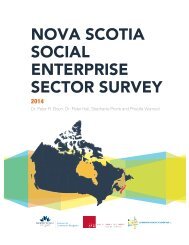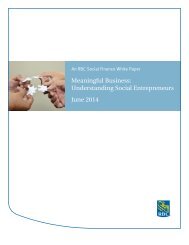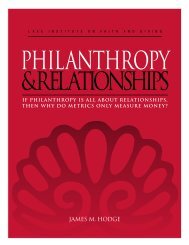Accelerating our Impact: Philanthropy, Innovation and Social Change
Create successful ePaper yourself
Turn your PDF publications into a flip-book with our unique Google optimized e-Paper software.
<strong>Accelerating</strong> <strong>our</strong> <strong>Impact</strong>: <strong>Philanthropy</strong>, <strong>Innovation</strong> <strong>and</strong> <strong>Social</strong> <strong>Change</strong> The J.W. McConnell Family Foundation<br />
Emergence (Renewal)<br />
Consolidation (Maturity)<br />
An example of panarchy: the PLAN experience<br />
Evidence of the panarchy model can be found in many contemporary social change<br />
programs. Planned Lifetime Advocacy Networks (PLAN) began as an innovation in<br />
Vancouver. Its purpose is to serve the families of individuals with intellectual<br />
disabilities by giving them practical advice about such things as will <strong>and</strong> estate<br />
planning. In addition, it provides a vital social network function – <strong>and</strong> peace of mind<br />
to aging parents – by supporting a life-long relationship between the individual with<br />
a disability <strong>and</strong> a circle of friends <strong>and</strong> family. This initial organizational design<br />
corresponds to the birth <strong>and</strong> consolidation cycle in the panarchy model.<br />
Birth<br />
Creative Destruction<br />
As it spread outside of British Columbia, PLAN began to change even while preserving<br />
its core business – the services that it is offering to families. Its founders broadened<br />
their focus by posing a different question: “What is a good life for individuals<br />
with disabilities?”, which led to a growing emphasis on increasing opportunities for<br />
people who are isolated <strong>and</strong> labeled to experience contribution <strong>and</strong> citizenship.<br />
Further, the organization began to substantially exp<strong>and</strong> its model of social enterprise<br />
to generate income for its programs <strong>and</strong> services.<br />
The panarchy concept first described by the ecologist C.S. Holling 8 is one thoughtprovoking<br />
way to look at the life cycles of social innovations (<strong>and</strong> often organizations)<br />
as they are invented, tested <strong>and</strong> spread, then decline <strong>and</strong> either disappear or re-emerge<br />
as new approaches or entities.<br />
“The ecocycle concept is used in biology <strong>and</strong> depicted as an infinity loop. In this case,<br />
the S curve of [a typical] business life cycle model (birth, growth <strong>and</strong> maturity) is<br />
complemented by a reverse S curve. It is the reverse S curve shown here with the<br />
dotted line that represents the death <strong>and</strong> conception of living systems. In <strong>our</strong><br />
depiction of the model, we call these stages creative destruction <strong>and</strong> renewal. The<br />
importance of the infinity loop is that it shows there is no beginning or end. The<br />
stages are all connected to each other. Hence renewal <strong>and</strong> destruction are part of an<br />
PLAN founders Al Etmanski <strong>and</strong> Vickie Cammack concluded that “To achieve<br />
sustainability, PLAN needs to get its principles, concepts <strong>and</strong> values into the ‘water<br />
supply.’ This will happen when we’ve succeeded in embedding a full citizen perspective<br />
into <strong>our</strong> social structures <strong>and</strong> institutions, <strong>and</strong> in changing the cultural<br />
consciousness from needs <strong>and</strong> inability to contribution <strong>and</strong> participation. This is not<br />
a quickly achievable objective – it will likely take a generation or two.”<br />
It could be argued that PLAN went through a period of “creative destruction” <strong>and</strong><br />
“renewal” as it wrestled with the challenge of achieving impact. This took some time,<br />
<strong>and</strong> the conversations among staff, board members <strong>and</strong> affiliates were not always<br />
smooth. Ultimately, they led to a shift in focus from establishing PLAN affiliates<br />
across Canada <strong>and</strong> abroad to working on changing perceptions <strong>and</strong> systems in<br />
support of people with disabilities. To achieve this broader goal, the original PLAN<br />
organization created a new entity, the PLAN Institute for Caring Citizenship.<br />
ongoing process”. 9 8 C.S. Holling <strong>and</strong> L. Gunderson, eds. Panarchy: Underst<strong>and</strong>ing Transformations in Human <strong>and</strong> Natural<br />
16<br />
Systems. Washington: Isl<strong>and</strong> Press, 2002.<br />
9 See Brenda Zimmerman <strong>and</strong> David Hurst. “From Life Cycle to Ecocycle: A New Perspective on the Growth,<br />
Maturity, Destruction <strong>and</strong> Renewal of Complex Systems.” J<strong>our</strong>nal of Management Inquiry 3.4 (1994): 339-<br />
354. See also the work of the Resilience Alliance at < http:// www.resalliance.org > .<br />
17







